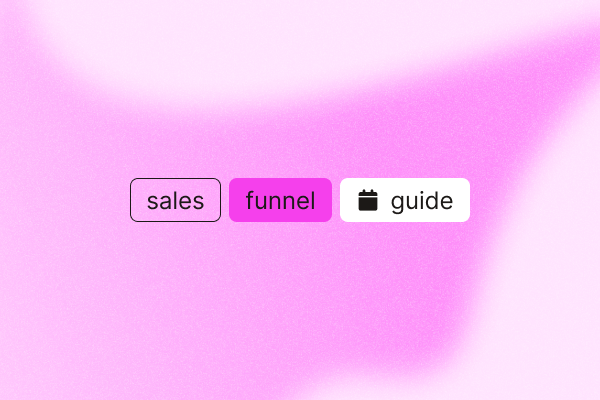Every B2B prospect moves through a specific path to become a customer. This path—called a B2B sales funnel—is the very foundation for your sales process.
It covers every aspect of your customer interaction, from lead generation to conversion.
Let’s look in-depth into B2B sales funnels and the actions you can take to improve yours.
AI highlights
- A B2B sales funnel is a representation of how a prospect moves toward conversion while interacting with your business.
- B2B sales funnels help you implement targeted sales, improve lead management, spot inefficiencies in the sales process, better understand customers, and create predictable revenue streams.
- Every B2B sales funnel includes six key stages:
| Stage | Description | Optimization Top Tip |
| Awareness | Involves prospects understanding their problems and looking for solutions. | Use SEO and content marketing to attract relevant traffic. |
| Interest | Prospects start showing interest in your brand and its solutions. They willingly give more contact details. | Offer lead magnets like eBooks or webinars to capture contact info. |
| Consideration | They start considering various solution providers to solve their issues. | Provide case studies and comparison guides to build trust. |
| Intent | Prospects start showing intent to make a purchase. | Use retargeting ads and personalized email follow-ups. |
| Evaluation | Prospects closely evaluate the last few options before making a purchase decision. | Highlight testimonials and reviews. |
| Conversion | They take action and finally buy from you. | Simplify the checkout process and offer limited-time incentives. |
What is a B2B sales funnel?
A B2B sales funnel visually maps the prospect‘s journey from discovering your brand to becoming a customer.
It is a visual representation of the steps that a B2B prospect takes throughout their interactions with your business.
At every stage of the B2B sales funnel, potential buyers, sales reps, and marketers interact with each other in different ways.
For example, during the awareness stage, a buyer may find a seller’s blog post. In the consideration phase, they could attend a webinar, and at the decision stage, they might have a demo with a sales rep to discuss pricing and features.
Why should your sales team create a B2B sales funnel?
Your prospects have different questions and goals at each stage of their journey toward becoming your customers.
With a B2B sales funnel, you’ll know what needs to be done to get them to convert.
Here’s how a sales funnel helps drive your revenue:
- Targeted sales: Your sales team will know exactly what prospects want at a given point, enabling them to provide relevant guidance to potential clients to win their trust.
- Spot inefficiencies: Track your performance at each stage (and as a whole), which will allow you to find inefficiencies in the process and make the most of each sales opportunity.
- Effective pipeline management: B2B purchases involve many stakeholders, and communication with your sales team can get complicated, especially across multiple channels. Sales funnels simplify this by providing visibility into each lead’s status.
- Understand customers better: Get customer behavior and preferences data as they move through your B2B sales funnel. This will help you make data-driven decisions about your sales process and product.
- Predictable revenue: By tracking conversion data for each stage of the B2B sales funnel, you can easily predict your future sales.
What are the stages of a B2B sales funnel?
B2B sales funnels vary slightly between companies based on their business model, sales cycle length, and products.
However, the typical B2B sales funnel includes six stages, from awareness (when prospects discover your brand) to conversion (when they buy from you).
These six stages can broadly be classified into three main segments:
- Top of the funnel (TOFU): Awareness and Interest stages.
- Middle of the funnel (MOFU): Consideration and Intent stages.
- Bottom of the funnel (BOFU): Evaluation and Conversion stages.
Let’s now take an in-depth look at each stage.
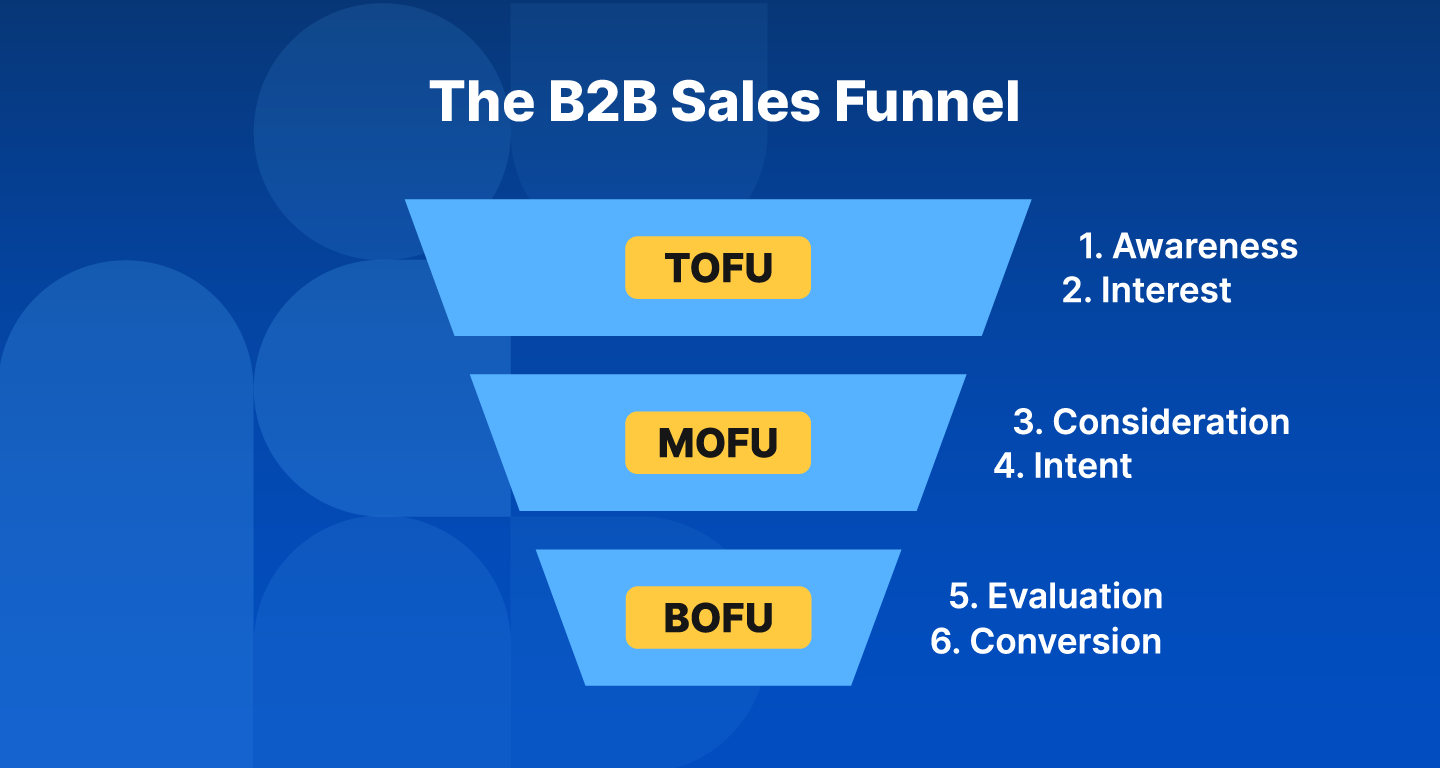
1. Awareness stage
In the Awareness Stage, potential customers recognize their needs or pain points and discover your brand.
They might research solutions through social networks or web searches. At this stage, your goal is to gather info on these prospects. For example, monitor their activity on your website or LinkedIn.
If a decision-maker visits your LinkedIn profile often, get to know his profile using tools like the LinkedIn Profile Scraper.
The best content for this stage would be blog posts, social media posts, and videos. They can help you efficiently generate awareness about your brand.
2. Interest stage
At this stage, prospects are interested in solving their problems and might be looking into how your brand can help them achieve that.
They may download eBooks, sign up for webinars, or interact with other content. And you’ll get their contact info thanks to your gate content.
Once you have their details, your sales team can reach out, ask about their needs, and start building a relationship.
3. Consideration stage
Your leads will start considering different options to solve their problems at this stage. They’ll conduct deeper research into different products or services.
The key difference between the Interest and Consideration stages is the lead’s focus. They’re now sure about the type of solution they need and are refining their choices to find the best available options.
You can share whitepapers, case studies, and comparison guides with them at this stage to help them see how your product stands out.
4. Intent stage
While your leads might be considering your product as a potential option in the Consideration stage, they don’t show any buying signals at that point. This changes in the Intent stage.
The lead shows strong interest in your product or service and gives interesting buying signals. For instance, they may contact your support team for specific features or pricing.
As a result, they would need additional details or reassurance about your brand or product. You can use product demos, pricing pages, and trials to show why your product is the right solution for their problems.
5. Evaluation stage
At this point, your leads evaluate the solutions from a narrowed list of options before making the final purchase decision. While the purchase is imminent, you must give them a little nudge to overcome the final hurdle.
You need to circle back to the main factors affecting purchase decisions, such as pricing, features, and customer support, and reassure the leads with hard data and related success stories.
Customer testimonials and detailed case studies can play a major role in getting them to make the purchase.
6. Conversion stage
In the Conversion stage, the leads have decided to buy from you. Your goal should be to ensure they face no hiccups in this process.
Be sure to provide a smooth checkout or sign-up experience and make it easy for them to reach customer support for any last-minute clarifications.
The content that works best at this stage is the type that pushes the leads to convert. For example, it includes the likes of limited-time discounts or exclusive deals.
How to optimize your B2B sales funnel?
Creating a B2B sales funnel is the first step, as it helps you grow your sales and revenue.
But once you’ve done it, it’s also important to continuously optimize it for the best results. So, here are the strategies you can use to improve your sales funnel and convert potential customers.
Define your Ideal Customer Profile (ICP)
A well-defined ICP will help you focus your marketing and sales efforts. This will enhance the relevance of your product and messaging, making your campaigns more effective for your target audience.
Paul Echaiz Guevara, COO of Sypher, recently spoke about this in his LinkedIn post. He mentioned how young companies trying to sell to everyone are counterproductive.

When you know exactly who you’re targeting, you can craft sharp and relevant messages, make your sales more efficient, and seamlessly predict results.
Extract leads showing buying intent
Leads drop off at each stage of the B2B sales funnel primarily because not all have a genuine buying intent.
That’s when intent data steps in. It helps you find warm leads already showing buying signals, such as participating in relevant industry events or interacting with your competitors.
We recommend using PhantomBuster’s LinkedIn Post Commenter and Liker Scraper to find such leads. All you need is the URL of a company page or personal profile to get started. For example, you can choose your competitors’ profiles for this (or your own!).
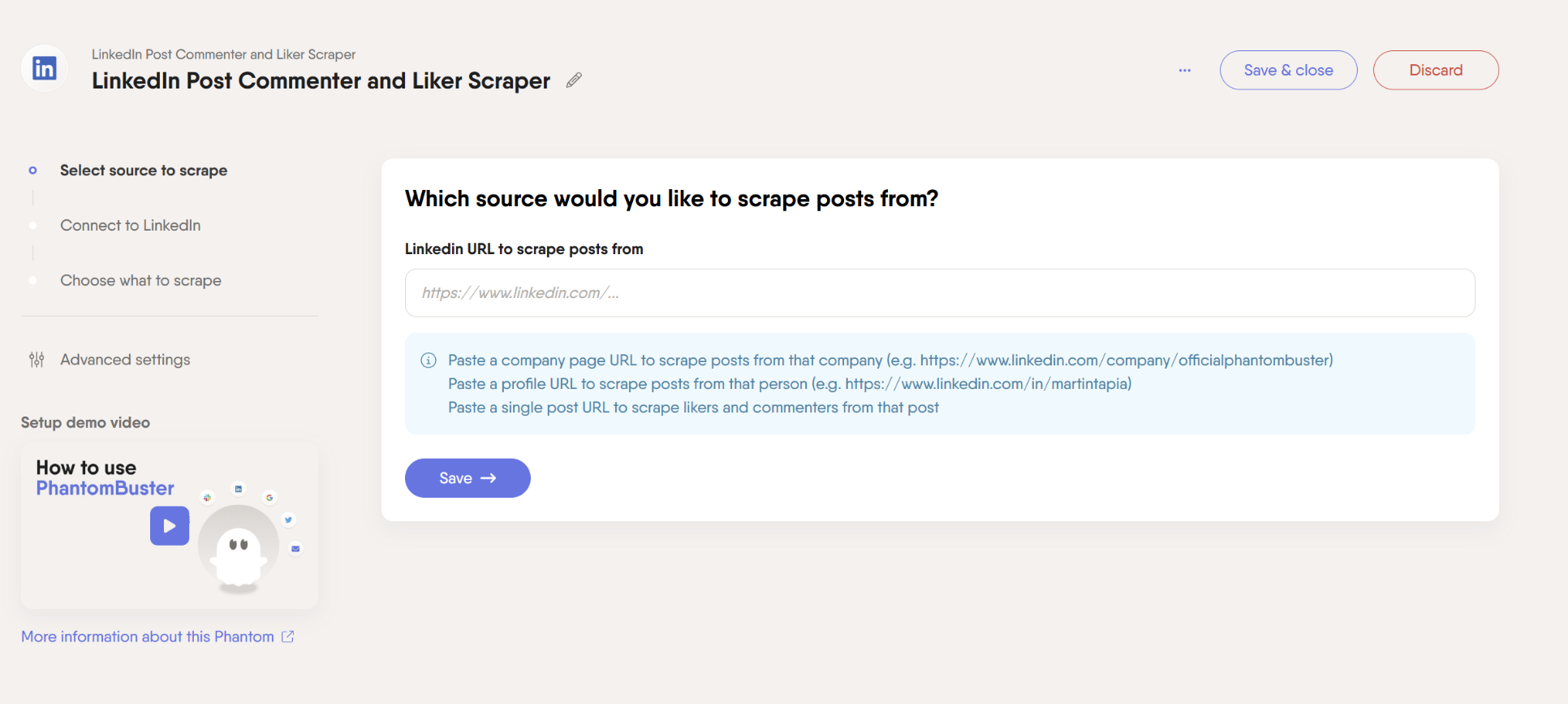
The tool will automatically scrape the engagements on the posts by the profile (likes and comments) to identify leads, so you have a ready-to-use list of prospects.
Create content for all the sales funnel stages
Your prospects have different expectations at each stage of the B2B sales funnel, so your content should reflect that.
For instance, blog posts and LinkedIn posts work well in the Awareness stage, while case studies are better suited in the Consideration stage.
The key is to create different types of content and use them in the right places. Getting these two factors right can help you create an impact with your content.
As Melissa Rosenthal, Co-Founder at Outlever, mentions in her LinkedIn post, “It’s time to reimagine ICP.” Along with the Ideal Customer Profile, you should also have an “Ideal Content Profile” that helps you create content that resonates with your leads.
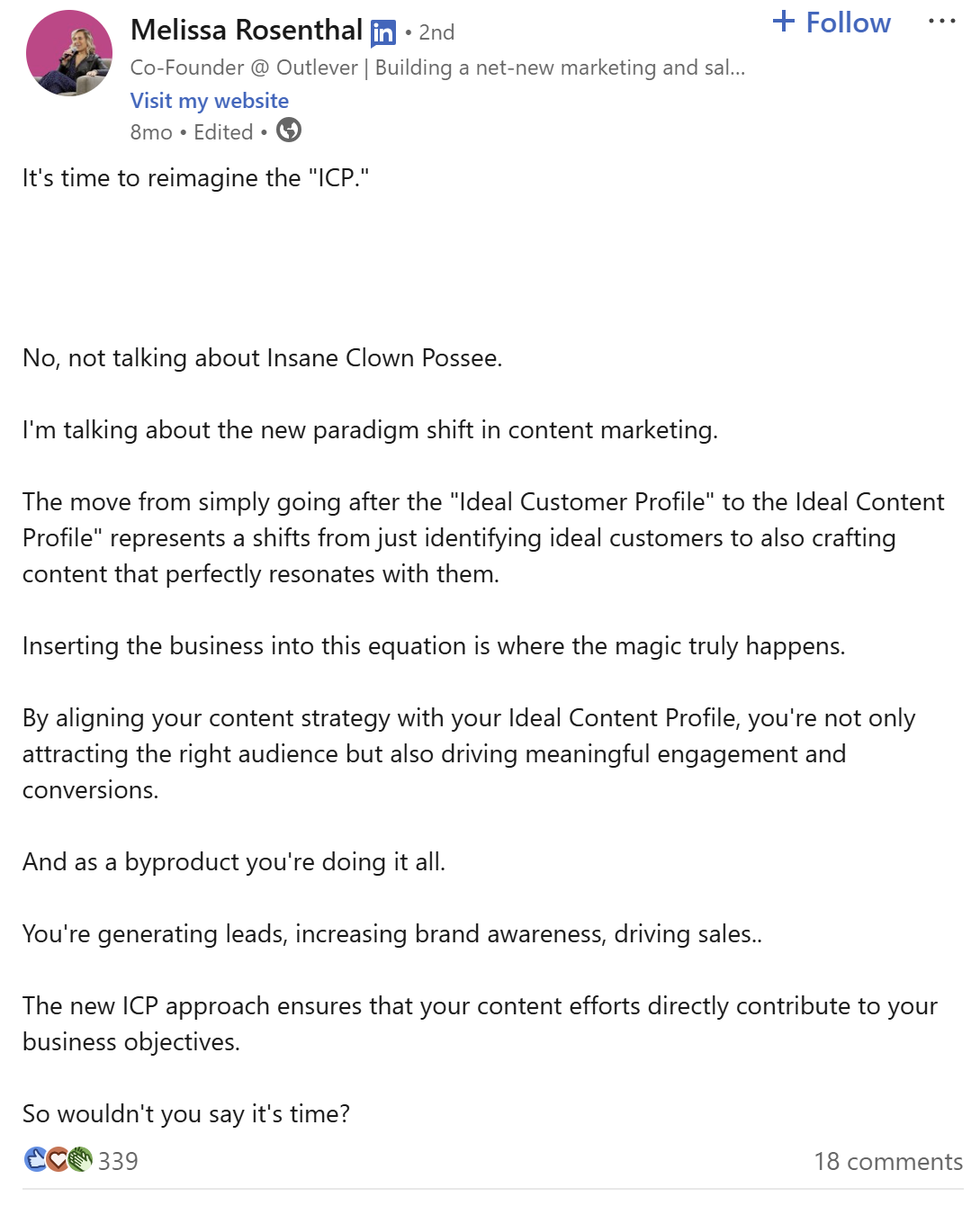
This will help you educate potential customers and move them down the sales funnel.
Build powerful landing pages
Landing pages play a critical role in lead generation by capturing prospects’ contact information as long as they’re well-optimized.
Some strategies to achieve this include:
- Write compelling headings.
- Keep the messaging clear.
- Use actionable CTAs and place them at hotspots.
- Keep your forms short.
Check out this landing page from Product Fruits. It has two clear CTA buttons and simple text that gets straight to the point. The title and image match the page’s intent, making it easy for users to engage and take action.
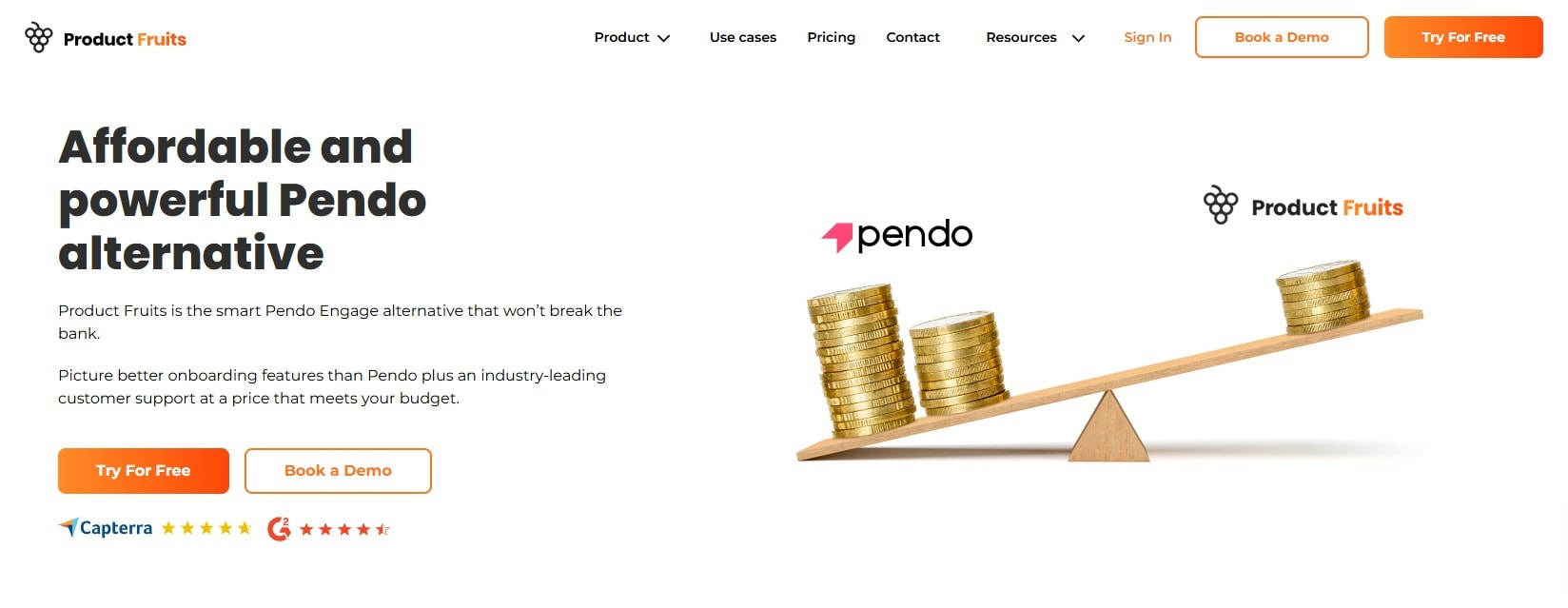
Prioritize potential customers through lead qualification
Reaching out to every lead in your prospecting list can be time-consuming. A better approach is to prioritize potential buyers using lead scoring.
Gather data on your prospects and qualify your leads to see who ticks all the right boxes. Those are the ones you should pursue first, as they’re more likely to convert.
PhantomBuster’s AI LinkedIn Profile Enricher can help you automate this process. All you have to do is write a detailed prompt to classify your leads according to your criteria, and it’ll score your leads based on their conversion likelihood.
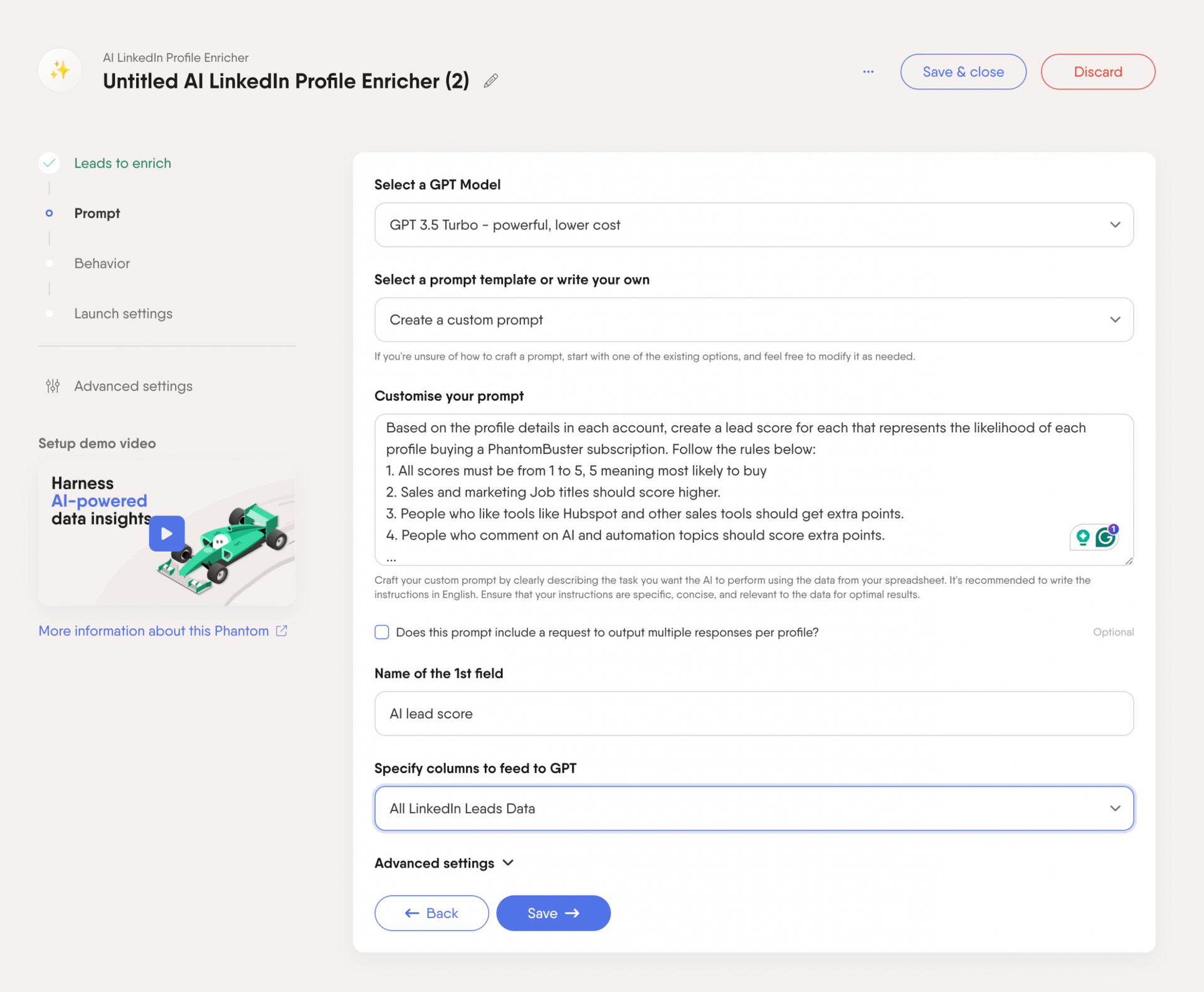
Here’s an example you can use:
Based on the profile details in each account, create a lead score for each that represents the likelihood of each profile buying a [Company Name] subscription. Follow the rules below:
1. All scores must be from 1 to 5, meaning most likely to buy.
2. [Job Titles] should score higher.
3. People who like tools like [Competitor] should get extra points.
4. People who comment on [Topics] should score extra points.
Automate your social selling to build trust
Creating a solid social media presence on LinkedIn and building authentic connections with prospects is a great way of building trust.
But as you might have guessed, this social selling process can be long. The good news is that automation can take some steps out of this process.
Try using a tool like PhantomBuster’s LinkedIn Auto Follow to warm up your leads before connecting with them. It automatically follows your target leads so your profile gets noticed before you reach out to them.
From there, you can move forward by engaging with their content or sending a connection request.
Leverage personalized sales outreach
Personalization in sales outreach is not just nice; it’s a must.
The proof is that 66% of B2B customers expect personalization while buying a product or service. More than half of them also want personalization in other sales process stages.

So, when you conduct sales outreach, you should customize it as much as possible. Here are a few tips to help you do this:
- Use their language of choice for communication.
- Mention their industry and how your solution can help solve their pain points.
- Use AI tools to create highly targeted email automation sequences based on their profile and recent engagement.
Keep your CRM clean and actionable
If you don’t manage your sales list well, it could quickly swell up with dirty data. And you don’t want to waste your resources reaching out to prospects who don’t match your ICP.
To avoid this, routinely go through your CRM and clean it up by removing the following:
- Prospects who don’t match your ICP.
- Entries with false data.
- Duplicate entries.
For instance, we recommend using the HubSpot Contact Sender automation to send your list of LinkedIn leads directly to HubSpot without you lifting a finger.
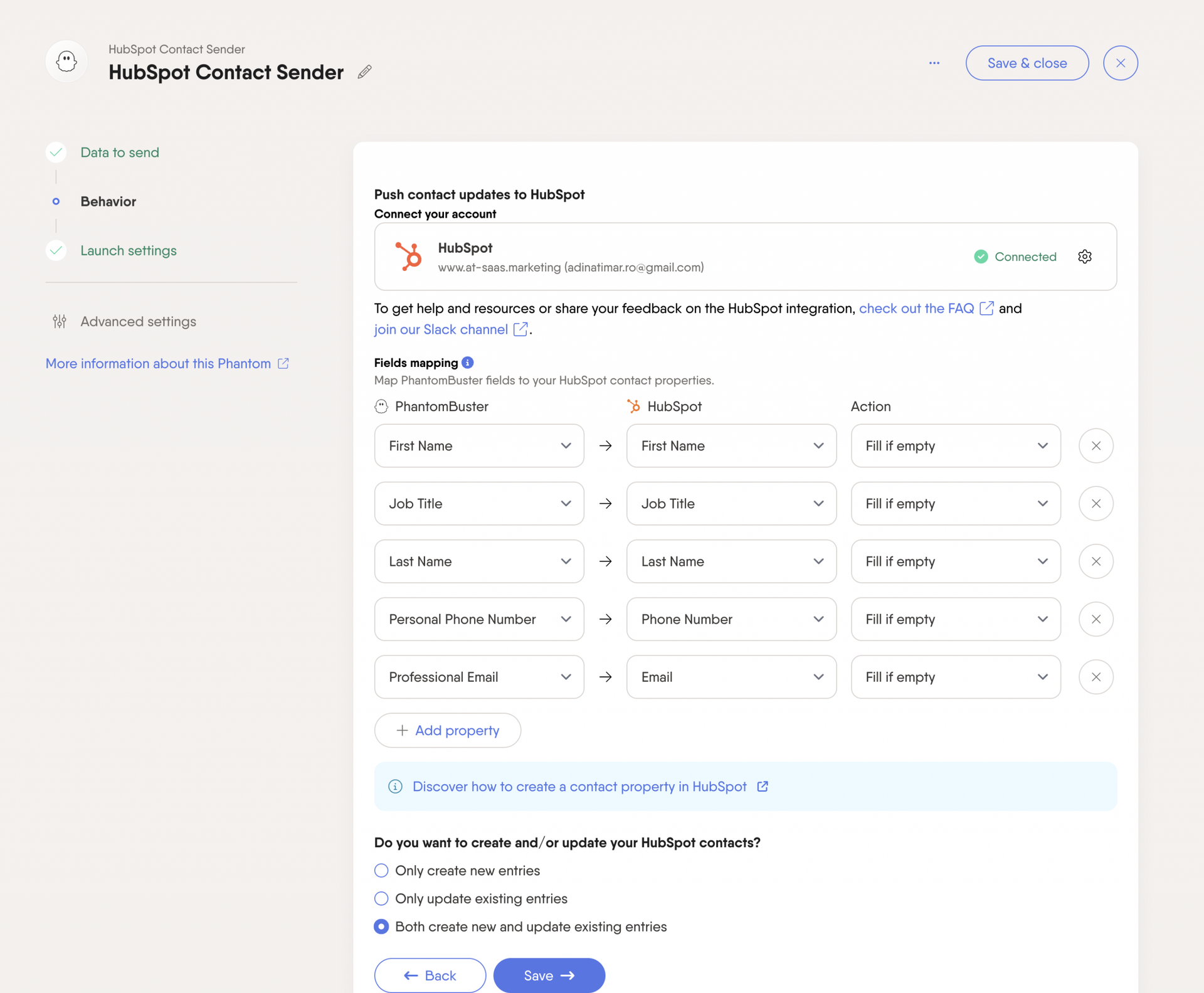
Align your sales and marketing teams
Marketing and sales teams must collaborate to push leads through the funnel effectively.
Both teams can work towards a common strategy by setting shared goals and improving communication with productivity tools.
Sales focuses on converting leads at the bottom of the funnel, while marketing drives traffic at the top.
When aligned, they can share insights—for example, sales can highlight common client issues, and marketing strategy can be modified accordingly to create content around the
Ana Rabaça, marketer at Otonomee, details strategies for aligning sales and marketing in this LinkedIn post. She talks about how both teams “need flow” by mapping customer journeys together, speaking the same language, and adopting a test-and-learn approach.
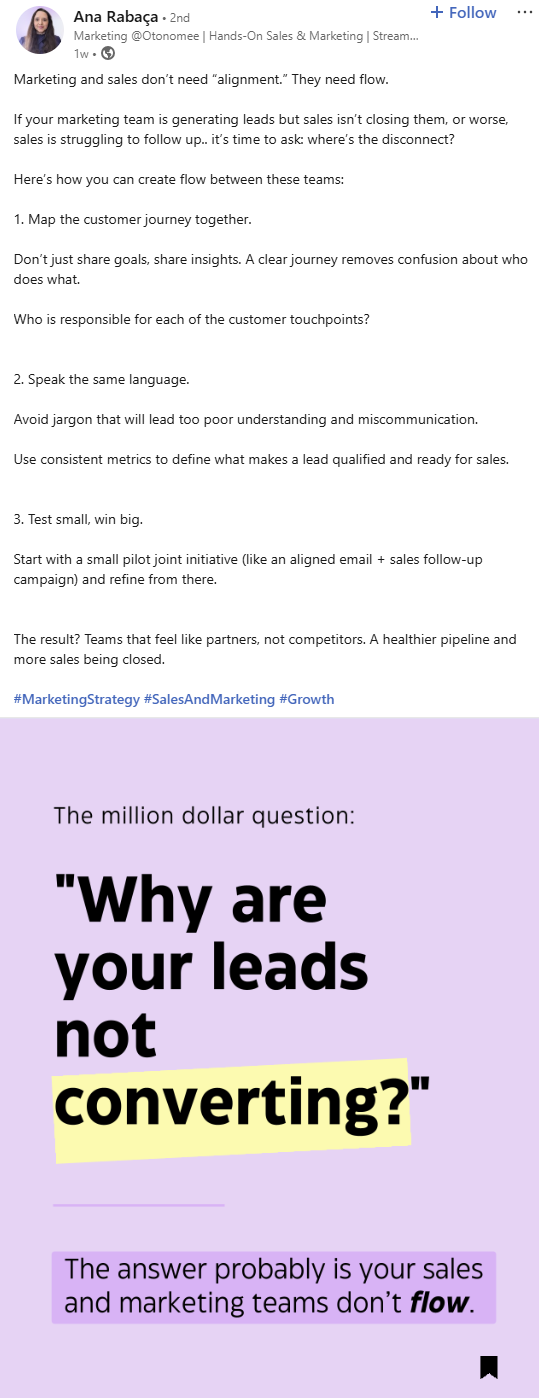
B2B sales funnel FAQ
B2B sales funnel vs. B2B marketing funnel: Key differences
Both B2B sales and B2B marketing funnels deal with the buying process. While the latter brings leads, the former converts them into customers by building relationships.
For example, marketing funnels deal with a prospect’s interaction with your brand’s content, while sales funnels are mostly about their interaction with your sales team.
What’s the difference between B2B and B2C sales funnels?
The key difference between a B2B and a B2C sales funnel is that B2B ones are more complex and longer than the latter.
This comes from the fact that B2B purchase decisions involve more deliberations and multiple stakeholders.
How do a sales funnel and a sales pipeline differ from each other?
Sales funnels track a buyer’s journey from prospect to customer. On the other hand, sales pipelines look at the seller, and the actions they take to move leads through the sales process.
What are the key B2B sales funnel metrics?
It’s essential to track B2B sales funnel metrics to determine how well your sales strategies are working.
Here are some of the most important metrics to track:
- Lead volume.
- Sales cycle length.
- Sales velocity.
- Average deal size.
- Customer acquisition cost (CAC).
- Lifetime value (LTV).
